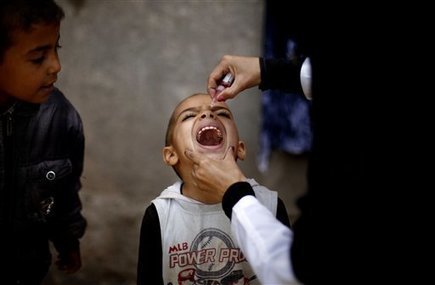Health officials are rushing a genetically engineered product into the field to counter uncontained outbreaks of vaccine-derived polio. To stem a growing polio crisis, health officials are accelerating the development of a new oral vaccine with plans for emergency approval and deployment in regions with active polio transmission as early as June 2020. The new vaccine, called nOPV2, might conclusively end the outbreaks, caused by the live virus in the vaccine reverting to a virulent form. But expedited approval means skipping the real-world testing of large clinical trials. Instead, key questions about the vaccine’s effectiveness will be answered in the field. “The nOPV strains have been tested in a small number of volunteers and we do not see reversion to neurovirulence,” says Vincent Racaniello, a virologist at Columbia University, “but when they are used for mass immunization of millions of individuals, rare events can become evident.”
Oral polio vaccine strains, originally developed by Albert Sabin in the 1950s, can in rare instances revert to virulence, spread, and paralyze children just like polio itself, a phenomenon first recognized in 2000. Because the Sabin vaccine had successfully eradicated wild type 2 poliovirus in 2015, health officials across the world quit administering it the following year. However, herd immunity had not been achieved before the cessation of the type 2 vaccine, which gave an opportunity for un-immunized people to later become infected by the virus that had begun reverting to virulence in people who had gotten the vaccine. With successive transmission through the unvaccinated, the vaccine strain can regain the virulence of wild polio. Nowadays, cases of polio caused by vaccine-derived strains outnumber those caused by the wild virus–and they continue to spread unchecked, most recently from the Phillipines to Malaysia. Vaccine-derived polio threatens as many as 210 million children globally, according to the World Health Organization. Using the reversion-prone Sabin type 2 vaccine to fight outbreaks caused more new outbreaks than it stopped, a virologist at the Centers for Disease Control and Prevention (CDC) told Science earlier this year.
nOPV2, the new type 2 oral polio vaccine, has been genetically engineered to avoid the pitfalls of Sabin’s vaccine. The project is funded by the Gates Foundation and coordinated by PATH, a nonprofit developer of public health innovations, with scientific work taking place at the National Institute for Biological Standards and Control (NIBSC) in the UK, the University of California, San Francisco, the CDC, and the Food and Drug Administration. Poliovirus “evolves readily to any situation it finds,” says Andrew Macadam, a principal scientist at NIBSC and a designer of nOPV2. As RNA viruses, polio and polio vaccine strains evolve using mutation and recombination. Polio “has a polymerase that is not very accurate,” says Macadam, so mutations occur frequently during replication. More importantly for rapid adaptation, recombination allows the virus to incorporate RNA strands from other C type enteroviruses in human hosts that enable gains in virulence. These partners include all the Sabin strains and Coxsackievirus, for example. nOPV2 obstructs some key genetic routes to pathogenicity, believed to be controlled by “gatekeeper” mutations. In particular, a single point mutation at nucleotide 481 increases neurovirulence and actually occurs in most people soon after immunization. The pivotal change at 481 makes a return to virulence possible, according to Macadam. “The gatekeeper idea,” he explains, “is that it needs to revert at 481 before it can do anything else and then you can incorporate these other mutations” that cause the vaccine to become pathogenic. So nOPV2 developers modified 18 nucleotides near 481 in the poliovirus genome so that the well-known single substitution no longer opens the gate to virulence. This safeguard in turn is protected from wholesale replacement via recombination by relocating a gene necessary for replication to another part of the genome so that if the modifications near 481 are lost through recombination, the gene needed for replication will also be lost. As a result, reversion “requires two recombination events instead of one,” according to Macadam, one being the acquisition of a second copy of the replication gene and the other being the loss of the 481-related modifications. “Therefore, it’s less likely,” says Macadam. In addition, Macadam’s team outfitted nOPV2 with a higher-fidelity polymerase that introduces fewer errors during replication while another gene received alterations to decrease the virus’ propensity for recombination....



 Your new post is loading...
Your new post is loading...








